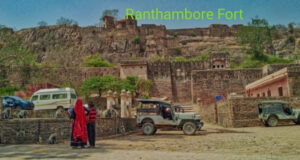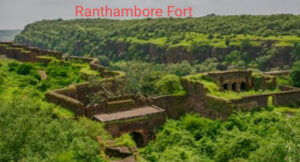Nestled in the heart of Rajasthan, Ranthambore Fort stands as a testament to India’s rich history and architectural grandeur. This imposing structure, located within the famous Ranthambore National Park, is not only a historical landmark but also a symbol of Rajasthan’s royal heritage. Known for its strategic importance and remarkable design, Ranthambore Fort attracts history enthusiasts, architecture aficionados, and nature lovers alike.

1.Ranthambore Fort: Historical Background
Ranthambore Fort’s origins can be traced back to the 10th century when it was initially built by the Chauhan dynasty. Over the centuries, it has seen the reign of several powerful rulers and dynasties, including the Mughals and the Rajputs. The fort was a significant stronghold during the reign of Prithviraj Chauhan, a legendary Rajput king. It has witnessed numerous battles and sieges, making it a focal point in the annals of Indian history.
One of the most notable rulers associated with Ranthambore Fort was Hammir Dev, who successfully defended the fort against the Sultan of Delhi, Alauddin Khilji, in the 13th century. This event is one of the many that highlight the fort’s resilience and strategic importance.
2.Ranthambore Fort : Architecture and Design
Ranthambore Fort is a masterpiece of Rajput architecture, showcasing a blend of Islamic and Hindu architectural styles. The fort complex is spread over a vast area and comprises several key structures and monuments, each with its own historical and architectural significance.
– Hammir’s Court: This was the royal court where Hammir Dev held his durbars and made significant decisions.
– Badal Mahal: Known for its beautiful frescoes and intricate carvings, Badal Mahal is a visual delight.
– Rani Haveli: This structure is believed to have been the residence of the royal women.
– Trinetra Ganesh Temple: One of the oldest temples within the fort, it is dedicated to Lord Ganesha and attracts devotees from far and wide.
The fort’s design includes massive gates, strong walls, and numerous bastions, making it an architectural marvel of its time. The strategic positioning of the fort on a high hill provided a vantage point for surveillance and defense.
3. Strategic Importance
The strategic location of Ranthambore Fort made it a critical defense point in Rajasthan. Positioned on the Aravalli and Vindhya hill ranges, the fort overlooked key trade routes and provided an excellent vantage point to monitor enemy movements. Its robust construction and formidable defenses made it a tough nut to crack for invaders, adding to its historical significance.
During different periods, the fort served as a major military outpost, witnessing several battles and sieges. Its control was often contested by various rulers, underscoring its strategic and military importance.

4.Cultural and Religious Significance
Ranthambore Fort is not just a military stronghold but also a place of cultural and religious importance. The fort houses several temples, the most prominent being the Trinetra Ganesh Temple. This temple, dedicated to Lord Ganesha, is a major pilgrimage site and hosts several festivals throughout the year.
The fort is also steeped in legends and myths, adding to its cultural allure. Stories of valor, love, and devotion associated with the fort have been passed down through generations, making it a significant cultural landmark.
5. Wildlife and Natural Beauty
Situated within Ranthambore National Park, the fort is surrounded by lush greenery and diverse wildlife. The national park is renowned for its tiger population, and visitors often spot these majestic creatures while exploring the fort. The area is also home to various species of birds, deer, and other wildlife, making it a haven for nature enthusiasts.
The fort’s surroundings are rich in flora, with dense forests and diverse plant species adding to the natural beauty of the site. The combination of historical architecture and natural splendor makes Ranthambore Fort a unique destination.
6.Visiting Ranthambore Fort
Ranthambore Fort is accessible from major cities like Jaipur and Delhi, with regular transportation options available. The best time to visit is between October and March when the weather is pleasant. Visitors can explore the fort on foot, with guided tours offering detailed insights into its history and significance.
For a comprehensive experience, tourists are advised to allocate sufficient time to explore both the fort and the national park. It’s also recommended to carry essentials like water, sunscreen, and comfortable footwear for the trek up to the fort.
Conclusion:
Ranthambore Fort is a remarkable blend of history, culture, and natural beauty. Its strategic importance, architectural grandeur, and rich cultural heritage make it a must-visit destination in Rajasthan. Preserving such historical sites is crucial for future generations to appreciate and learn from our rich past. A visit to Ranthambore Fort is not just a journey through history but also an opportunity to experience the breathtaking beauty of Rajasthan.
FAQ:
1.Why is Ranthambore Fort famous?
2.Is Ranthambore Fort worth visiting?
3.Is Ranthambore Fort free?
4.Who is the owner of Ranthambore Fort?
5.Ranthambore fort history
6.Ranthambore fort entry fee
7.Ranthambore Fort was built by

